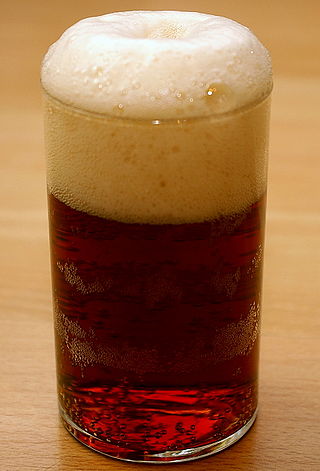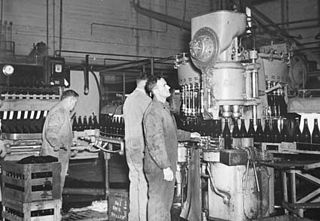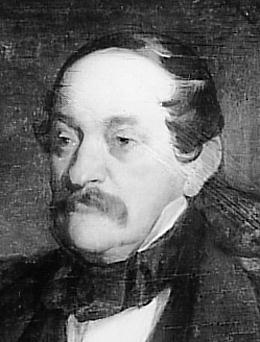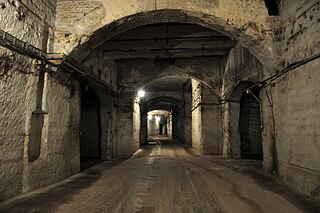This article needs additional citations for verification .(March 2013) |

Beer in Hungary has been brewed for well over a thousand years and the country has a significant history of commercial beer production.[ citation needed ]
This article needs additional citations for verification .(March 2013) |

Beer in Hungary has been brewed for well over a thousand years and the country has a significant history of commercial beer production.[ citation needed ]
The Hungarian word for beer is sör. The word itself is of Oghuric origin. [1] The word was most probably borrowed by the Hungarians in the era before the conquest of Hungary.
The first commercial brewery in Hungary was established in Buda in 1845 by Peter Schmidt. During the heyday of the Austro-Hungarian Empire, the Kőbánya district of Budapest became the centre of Hungary's brewing industry. The Dreher brewery is named after Anton Dreher, the creator of the Vienna lager style. He created the brewery in Budapest in 1862 and it came to dominate the Hungarian market before the Second World War.
Today, Hungary has four large commercial brewers which produce mainly light lagers (Hungarian : világos) and German-style dark beers (bocks, Hungarian : barna).
| Name | Owner | Founder | Famous products | Location | Website |
|---|---|---|---|---|---|
| Dreher Breweries (Dreher Sörgyárak) | Asahi Breweries [2] | Peter Schmidt (est. 1854) Anton Dreher (est. 1862) | Dreher Classic Arany Ászok Kőbányai Világos (pilsener-style lagers) Dreher Bak (a double bock) | Kőbánya, Budapest | |
| Borsod Brewery (Borsodi Sörgyár) | Molson Coors Brewing Company [3] | Magyar Országos Söripari Vállalat (est. 1973) | Borsodi Világos Borsodi Bivaly Borsodi Póló Borsodi Búza Borostyán (English: Amber) | Bőcs, Borsod-Abaúj-Zemplén | |
| Heineken Hungária (Heineken Magyarország) | Heineken | Julius Lenck (est. 1895) | Soproni Talléros (English: Coin Worth) Arany Hordó (English: Golden Barrel) Soproni Kinizsi Sárkány Sör (English: Dragon Beer) | Sopron, Győr-Moson-Sopron | |
| Pécs Brewery (Pécsi Sörfőzde) | Szemerey family [4] | Leopold Hirschfeld (1848) | Pécsi Szalon Szalon Barna Tavaszi Sör (English: Spring Beer) Három Király (English: Three Kings) | Pécs, Baranya |
Lately, some microbreweries have also set up in Hungary, such as Fóti, Legenda, Monyó, Csupor or Mad Scientist. In the 2010s, a lively craft beer scene evolved, with numerous local breweries, festivals and bottleshops. [5]
In the 1980s, beer consumption was roughly 100 litres per person, but since then it has declined to nearer seventy.[ citation needed ] Pale lager has about 90% of sales. [6]
In Hungary, people traditionally do not clink their glasses or mugs when drinking beer. There is an urban legend in Hungarian culture that Austrian generals clinked their beer glasses to celebrate the execution of the 13 Martyrs of Arad in 1849. Many people still follow the tradition, although younger people often disavow it, citing that the vow was only meant to last 150 years. [7]

Stella Artois is a pilsner beer, first brewed in 1926 by Brouwerij Artois in Leuven, Belgium. In its original form, the beer is 5.2 per cent ABV, the country's standard for pilsners. The beer is also sold in other countries including the UK, Ireland, Canada and Australia, where it has a reduced ABV. Stella Artois is owned by Interbrew International B.V. which is a subsidiary of the world's largest brewer, Anheuser-Busch InBev SA/NV.

Pale lager is a pale-to-golden lager beer with a well-attenuated body and a varying degree of noble hop bitterness.

Altbier is a style of beer brewed in the Rhineland, especially around the city of Düsseldorf, Germany. It is a copper coloured beer whose name comes from it being top-fermented, an older method than the bottom fermentation of lagers.

Castle Brewery is one of the oldest commercial breweries in South Africa. As company-endorsed legend would have it, the company was founded by Charles Glass in Johannesburg in 1894. UCT history professor Anne Kelk Mager has argued that the official SAB story overemphasized the role of Charles and that it was his wife Lisa Glass who was primarily responsible for the creation of Castle. It later merged with other breweries to form South African Breweries, which still later merged with Miller of the United States to form SABMiller.

Beer in Belgium includes pale ales, lambics, Flemish red ales, sour brown ales, strong ales and stouts. In 2018, there were 304 breweries in Belgium, including international companies, such as AB InBev, and traditional breweries, such as Trappist monasteries. On average, Belgians drink 68 litres of beer each year, down from around 200 each year in 1900. Most beers are bought or served in bottles, rather than cans, and almost every beer has its own branded, sometimes uniquely shaped, glass. In 2016, UNESCO inscribed Belgian beer culture on their list of the intangible cultural heritage of humanity.

Beer arrived in Australia at the beginning of British colonisation. In 2004 Australia was ranked fourth internationally in per capita beer consumption, at around 110 litres per year; although, the nation ranked considerably lower in a World Health Organization report of alcohol consumption per capita of 12.2 litres. Lager is by far the most popular type of beer consumed in Australia.

In the United States, beer are manufactured in breweries which range in size from industry giants to brew pubs and microbreweries. The United States produced 196 million barrels (23.0 GL) of beer in 2012, and consumes roughly 28 US gallons (110 L) of beer per capita annually. In 2011, the United States was ranked fifteenth in the world in per capita consumption, while total consumption was second only to China.
Beer in Africa, especially lager, is produced commercially in most African countries, and indigenous people also make varieties of beer. Beer is served in various locales, from neighbourhood shebeens to upscale bars. Many countries have standardized beer bottle sizes, which are cleaned and re-used, so when buying beer at a store, people often must pay a deposit on the bottle and the price of the beer. An alternative to glass-bottle beers is local beer sold in tetra-pak style paper cartons.

Beer is the most popular alcoholic drink in New Zealand, accounting for 63% of available alcohol for sale. At around 64.7 litres per person per annum, New Zealand is ranked 27th in global beer consumption per capita. The vast majority of beer produced in New Zealand is a type of lager, either pale or amber in colour, and typically 4–5% alcohol by volume.

Beer in the Netherlands mostly comprises pale lagers like Heineken and Grolsch. Heineken is the world's second-largest brewer.

Anton Dreher was an Austro-Hungarian brewer, business magnate, philanthropist of Danube Swabian ancestry, the founder of the Dreher Breweries who was an important figure in the development of pale lager.

Crown Lager is a 4.9% premium Australian beer originally made by Carlton & United Breweries (CUB), a subsidiary of Foster's Group. The beer was first brewed in 1919 under its former name, "Foster's Crown Lager".

Beer in Asia began when beer was produced in Sumer, Mesopotamia circa 6000 years ago. It was introduced by Europeans in the 19th century, with modern breweries established in British India, the Dutch East Indies, China, and Japan. Asia's first modern brewery was established in 1830 in India entirely using European brewing technology.
Heineken N.V. is a Dutch brewer which owns a worldwide portfolio of over 170 beer brands, mainly pale lager, though some other beer styles are produced. The two largest brands are Heineken and Tecate; though the portfolio includes Amstel, Fosters, Sagres, Cruzcampo, Skopsko, Affligem, Żywiec, Starobrno, Zagorka, Zlatý Bažant, Laško and Birra Moretti.
SABMiller was one of the top five global brewing companies, and had a range of over 150 beers, including international beers such as Pilsner Urquell, and Miller Genuine Draft, and local ones such as Gambrinus and Castle Milk Stout.

The beers of the Caribbean are unique to each island in the region, although many are variants of the same style. Each island generally brews its own unique pale lager, the occasional stout, and often a non-alcoholic malta beverage. Contract-brewing of international beers is also common, with Heineken Pilsener and Guinness Foreign Extra Stout being the most popular. The beers vary between the islands to suit the taste and the brewing method used.

Lager is a type of beer brewed and conditioned at low temperature. Lagers can be pale, amber, or dark. Pale lager is the most widely consumed and commercially available style of beer. The term "lager" comes from the German word for "storage", as the beer was stored before drinking, traditionally in the same cool caves in which it was fermented.

American lager or North American lager is pale lager that is produced in the United States. The pale lager-style beer originated in Europe in the mid-19th century, and moved to the US with German immigrants. As a general trend outside of Bavaria and the Czech Republic where the beers may be firmly hopped, pale lager developed as a modestly hopped beer, and sometimes used adjuncts such as rice or corn – and this was also true in the US.

Dreher (Kőbánya) Brewery in Budapest is owned by Asahi Breweries. Its main products are the Dreher Gold, Arany Ászok and Kőbányai Világos pilsener-style lagers but it also brews Dreher Bak, a full-bodied dark beer with a slight taste of caramel.

The Kőbánya cellar system or cellar system of Kőbánya, sometimes known to non-Hungarians simply as the Kőbánya Mine, or the Kobanya Mine, is an extensive network of subterranea, or underground spaces, in the 10th district of Budapest (Kőbánya), in Hungary. It is considered to be the largest cellar complex in the country. The complex as a whole started as an underground limestone quarry in a wine-growing area of present-day Kőbánya in the Middle Ages. Later wineries and beer breweries were established on the premises and they continued to use some of the underground spaces. During the Second World War, the dimensions of the complex enabled it to be used as a covert aircraft engine assembly plant and a civilian hideout. Since 2008, Kőbánya Asset Manager Jsc. organizes free guided tours annually, which introduce visitors to both the complex and the Havas Villa, one of the most notable properties connected to it. The underground complex is one of the locations that are participating in the European Heritage Days.